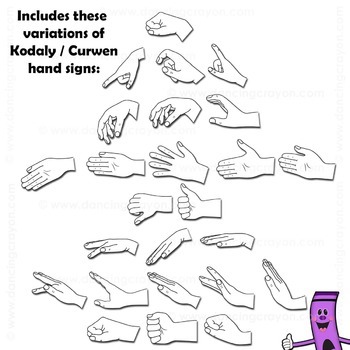

The Kodaly method uses these solfege hand signs for a few important reasons, but for novice singers they can simply be helpful in learning the basics of solfege. Ti – Make a loose fist, but point the index finger upward at about a 45-degree angle with the ceiling. La – Curve the hand gently, with the palm and fingertips facing the floor. Sol – Straighten the fingers so that the hand has the same shape as in mi, but tilt it so that your palm is directly facing you. Mi – Keep the same hand shape, but move your hand so that it is parallel with the ground.įa – Making a loose fist with four fingers (palm facing downward), extend your thumb and point it downward, almost perpendicular with the rest of the hand. Re – Straighten your fingers (keeping them together), and bring your hand up to make a 45-degree angle with the ground. Begin with your hand at about the level of your sternum, and make the following shapes as you sing each note of the major scale:ĭo – Make a fist with your palm facing down.
#Chromatic solfege hand signs free#
Using the solfege hand signs simply requires keeping one hand free while singing whichever one you like is fine. All of the hand signs can be produced using one hand, and can be helpful for singers who are new to the solfege system. The idea behind the solfege hand signs is simple: each tone of the seven-note solfege system is given a shape for the singer to make with his/her hand while singing.


The solfege hand signs (also called the Kodaly hand signs or the Curwen hand signs) were originally developed by John Curwen, but popularized through their use in the Kodaly method. The Kodaly method uses movable- do solfege, which we’ve discussed before, and adds one fantastic tool to the system: the solfege hand signs. One theorist in particular, Englishman John Curwen, gave Kodaly his ideas about solfege. Kodaly borrowed many of his ideas about teaching music from other pedagogues, including theorists in Britain and Switzerland. The Kodaly Method involves many different educational aims and subjects, and was primarily designed to make music education in Hungary’s elementary schools more effective. One of the most popular and well-known music teaching methodologies is the Kodaly Method, developed in the mid-twentieth century by Hungarian composer and music teacher Zoltan Kodaly. To maintain the highest quality instruction at his Academy, he continues to train at the world renowned Renzo Gracie Academy New York City with some of the best BJJ and MMA partitioners in the world.The solfege system as we know it dates all the way back to the 1800’s, and makes its way into many different methods of teaching singing and aural skills. Professor Mark is one of Renzo Gracie's first students in the U.S., and has over 23 years experience in BJJ under Renzo. Professor Mark Cerrone is 3rd° Brazilian jiu jitsu black belt under legendary Renzo Gracie (MMA pioneer, one of the world's most highly regarded Brazilian jiu jitsu practitioners and teachers and grandson of BJJ founder, Carlos Gracie) & John Danaher (TUF coach in BJJ trainer of many notable MMA and BJJ practitioners, Including UFC middleweight champion Chris Weidman, former welterweight champion George St Pierre, former lightweight champion Frankie Edgar, former welterweight champion Matt Serra and many others). The school is well known for its world class highest quality instruction as well as it’s friendly and cooperative atmosphere. Each student’s advancement is measured by consistency and own progress Effective movement into fight ending submissions Technique & leverage rather than brute strength. Renzo Gracie Jiu Jitsu Academy Milford is a Renzo Gracie Brazilian Jiu Jitsu/BJJ, Submission Grappling, Muay Thai and Mixed Martial Arts/MMA training academy. Welcome To The Renzo Gracie Jiu Jitsu Academy Milford!


 0 kommentar(er)
0 kommentar(er)
